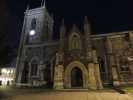Discover the...
Marlow Community Choir at Borlase
Antonio Vivaldi - Magnificat
MagnificatAntonio Vivaldi composed several settings of the Magnificat hymn. The original setting for single choir, RV 610, is generally indicated when Vivaldi's Magnificat is performed and discussed. RV 610 was composed either before 1717 or in 1719. Set in G minor, it is scored for 2 soprano soloists, alto and tenor soloists, SATB choir, violin I and II, viola, and basso continuo (cello and organ).
The work is divided into nine movements. Performances require approximately 20 minutes. All movements are scored for four-part chorus, strings and continuo, unless indicated otherwise.
- Magnificat anima mea Dominum Adagio, G minor, common time
This movement is similar to the second movement of the composer's Credo. - Et exultavit spiritus meus Allegro, B-flat major, common time; soprano solo
- Quia respexit humilitatem... alto solo, brief choral interjection at omnes generationes
- Quia fecit mihi magna... tenor solo
- Et misericordia ejus Andante molto, C minor, common time
This highly contrapuntal movement is considered the "musical heart" of the composition. - Fecit potentiam Presto, G minor, 3/4
- Deposuit potentes Presto, G minor, 3/4; unison choir
- Esurientes Allegro, B-flat major, common time; soprano duet; continuo only
- Suscepit Israel Largo, D minor, common time
- Recordatus misericordiae suae" Allegro
- Sicut locutus est Allegro ma non poco, F major, common time; SAB chorus; 2 oboes added to orchestration
- Gloria Patri... Largo, G minor, common time
This section recapitulates the opening movement.
- Sicut erat in principio... Andante
- Et in saecula saeculorum... Allegro
| Vivaldi's Magnificat: | www.learnchoralmusic.co.uk/Vivaldi/Magnificat/magnificat.html
|
Josef Haydn - Te Deum
Te DeumHaydn's second setting of the Te Deum was composed at the request of the Empress Marie Therese, wife of Franz I of Austria. The first recorded performance took place on 8th September 1800 at Eisenstadt, directed by the composer, at the name-day concert for Prince Nicholaus' wife Princess Marie. This was also the occasion of the first performance of the Missa in Augustii, (the ).
Rehearsal Aids/Downloadable Midi Part Files:
| Haydn's Te Deum Laudamus: | www.learnchoralmusic.co.uk/Haydn/Te-Deum/te-deum.html
|
Gabriel Faure - Cantique de Jean Racine
Cantique de Jean RacineCantique de Jean Racine (Op. 11) is a work for mixed chorus and piano or organ by Gabriel Fauré. Written by the nineteen-year-old composer in 1864–5, the piece won Fauré the first prize when he graduated from the École Niedermeyer de Paris and was first performed the following year on August 4, 1866, with accompaniment of strings and organ. It was first published around 1875 or 1876 (Schoen, Paris, as part of the series Echo des Maîtrises) and appeared in a version for orchestra (possibly by the composer) in 1906. The accompaniment has also been arranged for strings and harp by John Rutter.
The text, "Verbe égal au Très-Haut", is a paraphrase by Jean Racine (Hymnes traduites du Bréviaire romain, 1688) of the pseudo-ambrosian hymn for Tuesday matins, Consors paterni luminis.
Rehearsal Aids/Downloadable Midi Part Files:
| Faure's Cantique de Jean Racine: | www.learnchoralmusic.co.uk/Faure/Racine/Racine.html
|
| Rosi Shotter's French Pronunciation: | Rosi_Pronunication.mp3
|
| 'Real' French Pronunciation: | Real_Pronunication.mp3
|






